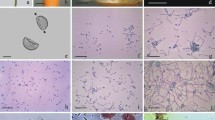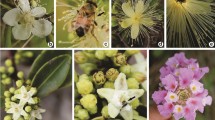Abstract
Petunia hybrida and Cucurbita pepo pollen was exposed to 30 and 75% relative humidity (RH). Water content, viability and carbohydrate content (glucose, fructose, sucrose and starch) were measured at fixed intervals over 6 h. Water content of C. pepo pollen decreased drastically at both RHs, while P. hybrida pollen dehydrated slightly at RH 30% and hydrated at RH 75%. The pollen of the two species also showed very different sensitivity to dehydration. P. hybrida pollen was resistant to desiccation, with viability remaining around 80% throughout the experiment, whereas C. pepo was very sensitive to desiccation, showing an abrupt decrease in viability when its water content reached about 13% (fresh weight basis) at both RHs. Carbohydrate content was also different in the two species. Sucrose content increased soon after dehydration of P. hybrida pollen at RH 30%, whereas it remained almost constant in C. pepo pollen at the same RH. The results are discussed in the framework of basic pollen physiology and of plant reproductive strategy.





Similar content being viewed by others
References
Alper P, Oliver ML (2002) Drying without dying. In: Black M, Pritchard HW (eds) Desiccation tolerance in plants. CAB International, Wallingford, pp 3–43
Aronne G (1999) Effects of relative humidity and temperature stress on pollen viability of Cistus incanus and Myrtus communis. Grana 38:364–367
Aylor DE (2003) Rate of dehydration of corn (Zea mays L.) pollen in the air. J Exp Bot 54:2307–2312
Boyle TM (2001) Environmental control of moisture content and viability in Schlumbergera truncate (Cactaceae) pollen. J Amer Soc Hort Sci 126:625–630
Buitink J (2000) Biological glasses: nature’s way to preserve life. PhD thesis. Wageningen Agricultural University, Wageningen
Buitink J, Leprince O (2004) Glass formation in plant anhydrobiotes: survival in the dry state. Cryobiology 48:215–228
Buitink J, Walters-Vertucci C, Hoekstra FA, Leprince O (1996) Calorimetric properties of dehydrating pollen: analysis of desiccation tolerant and intolerant species. Plant Physiol 111:235–242
Buitink J, Walters C, Hoekstra FA, Crane J (1998) Storage behavior of Typha latifolia pollen at low water contents: an interpretation on the basis of water activity and glass concepts. Physiol Plant 103:145–153
Buitink J, Leprince O, Hemminga MA, Hoekstra FA (2000) Molecular mobility in the cytoplasm: an approach to describe and predict lifespan of dry germplasm. PNAS U.S.A. 97:2385–2390
Dafni A (1992) Pollination ecology: a practical approach. Oxford University Press, Oxford
Dafni A, Firmage D (2000) Pollen viability and longevity: practical, ecological and evolutionary implications. In: Dafni A, Hesse M, Pacini E (eds) Pollen and pollination. Springer, Wien, pp 113–132
Fonseca AE, Westgate ME (2005) Relationship between desiccation and viability of maize pollen. Field Crop Res 94:114–125
Franchi GG, Bellani L, Nepi M, Pacini E (1996) Types of carbohydrate reserves in pollen: localization, systematic distribution and ecophysiological significance. Flora 191:143–159
Franchi GG, Nepi M, Dafni A, Pacini E (2002) Partially hydrated pollen: taxonomic distribution, ecological and evolutionary significance. Plant Syst Evol 234:211–227
Gay C, Kerhoas C, Dumas C (1987) Quality of a stress-sensitive Cucurbita pepo pollen. Planta 171:82–87
Guarnieri M, Speranza A, Nepi M, Artese D, Pacini E (2006) Ripe pollen carbohydrate changes in Trachycarpus fortunei: the effect of relative humidity. Sexual Plant Reprod 19:117–124
Heslop-Harrison J, Heslop-Harrison Y (1970) Evaluation of pollen viability by enzymatically induced fluorescence; intracellular hydrolysis of fluorescein diacetate. Stain Technol 45:25–36
Hoekstra FA, Crowe LM, Crowe JH (1989) Differential desiccation sensitivity of corn and Pennisetum pollen linked to their sucrose contents. Plant Cell Environ 12:83–91
Hoekstra FA, Crowe JH, Crowe LM, van Roekel T, Vermeer E (1992) Do phospholipids and sucrose determine membrane phase transitions in dehydrating species? Plant Cell Environ 15:601–606
Johansen DA (1940) Plant microtechnique. McGraw-Hill, New York
Kerhoas C, Gay CG, Duplan JC, Dumas C (1986) Water content evolution in Cucurbita pepo during ageing: a NMR study. In: Mulcahy DL, Bergamini Mulcahy G, Ottaviano E (eds) Biotechnology and ecology of pollen. Springer, New York, pp 502–505
Kerhoas C, Gay CG, Dumas C (1987) A multidisciplinary approach to the study of the plasma membrane of Zea mays pollen during controlled dehydration. Planta 171:1–10
Kleins M, Elster R-C, Rodrigo M-J, Blervacq A-S, Salamini F, Bartels D (1999) Isolation and expression analysis of two stress-responsive sucrose-synthase genes from the resurrection plant Craterostigma plantagineum (Hochst.). Planta 209:13–24
Kock K (2004) Sucrose metabolism: regulatory mechanisms and pivotal roles in sugar sensing and plant development. Curr Opin Plant Bio 7:235–246
Lansac AR, Sullivan CY, Johnson BE, Lee KW (1994) Viability of the pollen of Sorghum [Sorghum bicolor (L.) Moench]. Ann Bot 74:27–33
Leopold AC, Sun WQ, Bernal-Lugo I (1994) The glassy state in seeds: analysis and function. Seed Sci Res 4:267–274
Nepi M, Pacini E (1993) Pollination, pollen viability and pistil receptivity in Cucurbita pepo. Ann Bot 72:527–536
Nepi M, Franchi GG, Pacini E (2001) Pollen hydration status at dispersal: cytophysiological features and strategies. Protoplasma 216:171–180
O’Brien TP, McCully ME (1981) The study of plant structure–principles and selected methods. Termacarphi Pty, Melbourne
Pacini E (1996) Types and meaning of pollen carbohydrate reserves. Sexual Plant Reprod 9:362–366
Pacini E (2000) From anther and pollen ripening to pollen presentation. Plant Sys Evol 222:19–43
Potts M (1994) Desiccation tolerance of prokaryotes. Microbiol Rev 58:755–805
Rolland F, Sheen J (2005) Sugar sensing and signalling networks in plants. Biochem Soc T 33(part 1):269–271
Shivanna KR, Cresti M (1989) Effects of high humidity and temperature stress on pollen membrane integrity and pollen vigour in Nicotiana tabacum. Sexual Plant Reprod 2:137–141
Shivanna KR, Heslop-Harrison J (1981) Membrane state and pollen viability. Ann Bot 47:759–770
Speranza GE, Calzoni CL, Pacini E (1997) Occurrence of monosaccharides and polysaccharide reserves in mature pollen grains. Sex Plant Reprod 10:110–115
Stanley RG, Linskens HF (1974) Pollen: biology, biochemistry, management. Springer, New York
Vesprini JL, Nepi M, Cresti L, Guarnieri M, Pacini E (2002) Changes in cytoplasmic carbohydrate content during Helleborus pollen presentation. Grana 41:16–20
Winston PW, Bates DH (1960) Saturated salt solutions for the control of humidity in biological research. Ecology 41:232–237
Wolkers WF, Oldenhof H, Alberrda M, Hoekstra FA (1998) A Fourier transform infrared study of sugar glasses: application to anhydrobiotic higher plant cells. Biochim Biophys Acta 1379:83–96
Acknowledgments
This research was funded by PAR (Piano di Ateneo per la Ricerca, University of Siena).
Author information
Authors and Affiliations
Corresponding author
Rights and permissions
About this article
Cite this article
Nepi, M., Cresti, L., Guarnieri, M. et al. Effect of relative humidity on water content, viability and carbohydrate profile of Petunia hybrida and Cucurbita pepo pollen. Plant Syst Evol 284, 57–64 (2010). https://doi.org/10.1007/s00606-009-0237-x
Received:
Accepted:
Published:
Issue Date:
DOI: https://doi.org/10.1007/s00606-009-0237-x




